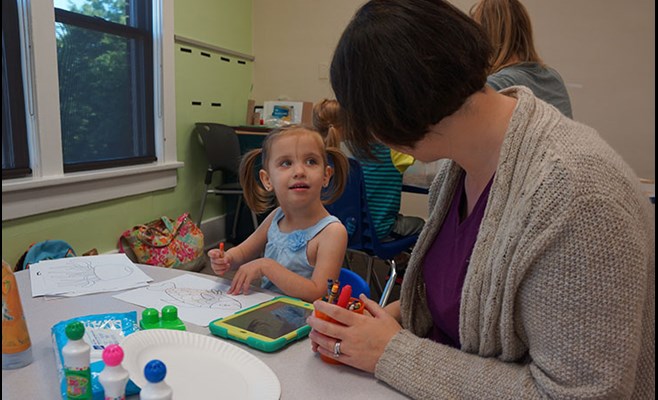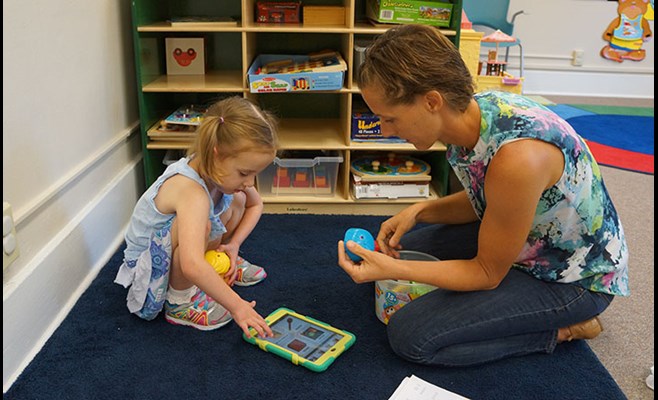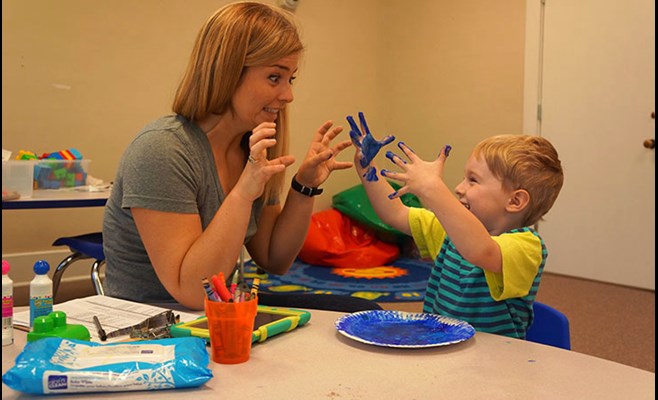U of A Students, Faculty Help Preschoolers With Autism Improve Communication

Ruby, one of 3-year-old twins, colors with graduate student Hollie Lawless.
Three-year-old Ruby reached for her mother, saying, "Mama."
"That was a highlight for me," Ashlee Milliken said. "She had made the sounds before but never in that way, not in a possessive way. That was really special for me."
Milliken was describing progress she saw her twin daughters, Ruby and Lilly, make just two weeks into a monthlong applied behavioral therapy preschool group conducted last month by the special education program at the University of Arkansas.
Milliken and her husband, Amery Seay, began to notice the twins not developing in typical fashion, particularly in their communication skills, when they were about 18 months old. They were experiencing some developmental delays as a result of being born prematurely — Ruby a little bigger than 5 pounds and Lilly a little smaller than 5 pounds — and had been receiving various types of therapy. After the girls' hearing was tested and found to be normal, the couple knew they needed to investigate.
"We got the autism diagnosis in January of this year," Milliken said. "Their speech therapist recommended they be tested because they weren't mimicking speech like most children do."
The girls were initially assessed through Project Connect, a program in the College of Education and Health Professions that provides autism education, assessment, referral and therapy services and is partially federally funded. Then, Ruby and Lilly received further testing in Little Rock.
Autism is a neurological disorder. The U.S. Centers for Disease Control and Prevention estimates that an average of 1 in 68 children in the United States has autism, which is characterized by varying degrees of impairment in communication skills, social interactions, and restricted and repetitive patterns of behavior.
"Getting a diagnosis that their autism is severe was really hard," Milliken said. "We were expecting it to be a diagnosis of high-functioning because they are so smart, but it was considered severe because they are nonverbal. Once we get communication skills established, that will help us see more of their capabilities."
Autism Clinic
Last year, the special education faculty and graduate students moved into a house on the corner of Arkansas Avenue and Maple Street. The building used to be the university's Speech and Hearing Clinic and was once a men's fraternity house.
The College of Education and Health Professions hired two professors in the past three years who are certified in applied behavior analysis on the doctoral level. Peggy Schaefer Whitby and Elizabeth Lorah are taking the special education program in a new direction, including creating a graduate certificate in applied behavior analysis as well as incorporating coursework into the special education master's program so that graduates can sit for the certification exam.
Applied behavior analysis is characterized by first understanding why problem behavior occurs and basing treatment on that understanding. It is used to bring about meaningful and positive changes in behavior.
In the preschool group that ran through June, master's and doctoral students in special education worked with four 3-year-olds under Lorah's supervision in a structured setting to help the children get ready for preschool. The group also allowed the faculty and students to continue their research into the use of iPads to help children with autism improve their communication skills.
The children rotated through centers as in a typical preschool, where they worked on puzzles, had books read to them, did crafts such as painting, built with blocks and put stickers on pictures. Each U of A student worked one-on-one with an assigned student in 10-minute sessions at each center.
Further Education
Hollie Lawless taught kindergarten in Springdale for 12 years and planned to return to school eventually for graduate work. One day, a child entered her classroom who was diagnosed with high-functioning autism.
"But I wasn't equipped to give her the best education she deserved," Lawless said. "That stoked something in me. I entered the field of applied behavior analysis by chance, working in some in-home programs, and I saw it work. I wanted to be involved."
Lawless has finished the coursework for a master's degree in special education and has two courses left to complete for the U of A applied behavior analysis graduate certificate.
As part of a practicum she is doing in the clinic, she is required to write a research paper she hopes to publish in an academic journal. Her research project is about teaching the children the beginning steps of using the iPad - how to press the home button, swipe across the screen and find what they are looking for. Depending on the baseline assessment each child receives at the beginning of the project, she teaches more complex operations on the iPad.
"I'm breaking it down into steps," Lawless said. "If they can't get in (to the IPad), it doesn't help them."
Within each center, the children made choices of what they wanted to do or which books they wanted to read, and the iPads had pictures of those items for them to tell the U of A students what they wanted.
"They are manding for objects," Lawless said. "When they use the iPad, we vocalize the word. If they push the picture of a doll bed because they want to put the doll in the bed in the dollhouse, we say 'bed.' They are asking for what they want, even though they are using an augmentative device. They get frustrated if they can't get their needs met."
Lorah explained that behavior psychologist B.F. Skinner coined the term "manding," among others, to describe the process of requesting an object or activity.
"We are doing manding training in applied behavior analysis," Lorah said. "It's the first step in any good behavior analytic program for children with autism, who often lack the ability to mand. If you have a 3-year-old who has never been able to ask for food, what do they do? They cry, kick and so on. We teach them replacement behaviors."
The group focused on preschool readiness skills such as knowing and identifying colors, shapes, numbers and letters, Lorah said. Her dissertation research at Temple University examined the results of using vocal-generating technology compared to picture-based communication models. Her work at the U of A continues that research.
"The results so far have been really good," she said.
Lorah, Whitby and their students have published their research in leading academic publications such as the Journal of Physiological and Developmental Disability, the Journal of Autism and Development Disability and Research in Autism Spectrum Disorders. They also have presented their research at academic conferences.
"I think students need to engage in research in order to become good clinicians," Lorah said.
Making Progress
Milliken stays home with Ruby and Lilly, and they receive about 16 hours of private therapy a week. She is glad they had the opportunity to join the preschool group and be exposed to applied behavior analysis.
"This is their first real preschool setting, their first structured environment," Milliken said. "They had never touched an iPad before. The first day was really hard. They struggled because they like to do whatever is their idea. They were protesting a lot."
However, the second day, Milliken recalled, the girls were more receptive. Ruby ran to the clinic play area, requesting puzzle pieces. They are more engaged with other people now, she said. One of their private therapists has noted they respond to their names more and make eye contact more, a big change, Milliken said.
The family received a grant to purchase iPads for home and will get training from Project Connect on how to use them effectively to help the girls continue their progress. They are on a waiting list for applied behavior analysis therapy through the Arkansas Autism Partnership, a statewide program based in the College of Education and Health Professions.
"The sad part is that there are not enough resources," Milliken said, for families of children with autism. "Now we know what we have been missing."
Topics
Contacts
Heidi Wells, director of communications
College of Education and Health Professions
479-575-3138,
heidisw@uark.edu
Headlines
U of A's Inspirational Chorale Makes Its Carnegie Hall Debut
The U of A's Inspirational Chorale took center stage at Carnegie Hall in March, performing under the direction of professor Jeffrey Murdock to a packed audience at the iconic Stern Auditorium.
The State of Economics With Mervin Jebaraj Set for June 5
U of A economist Mervin Jebaraj will analyze state's economic trends and regional issues in an upcoming talk. Preregistration is required by May 31.
Faculty Demonstrate Dedication to Student Success Through Teaching Credentials
Eight faculty members from across the U of A have earned the prestigious Association of College and University Educators certification in Effective College Teaching.
Artificial Intelligence, Machine Learning Boost Arkansas Animal Science Research
Aranyak Goswami, a bioinformatics specialist, will work with three different departments to boost the research arm of the U of A System Division of Agriculture.
College of Education and Health Professions Doctoral Student Picked for Grosvenor Fellowship
Jessica Culver, a doctoral student in the College of Education and Health Professions Adult and Lifelong Learning program, has been selected as a member of the 2024 Grosvenor Teacher Fellowship.








